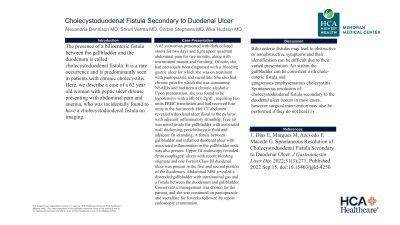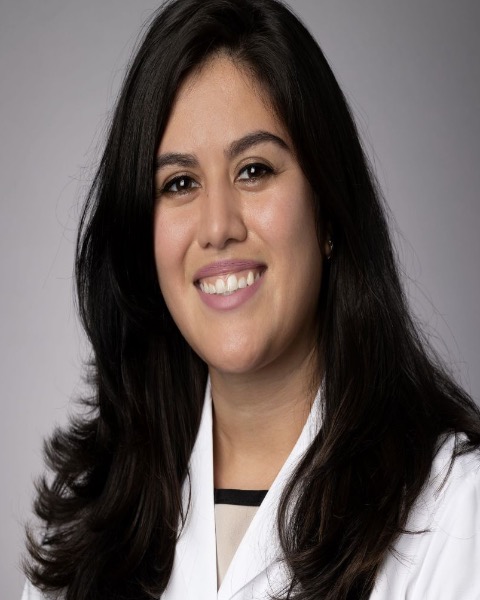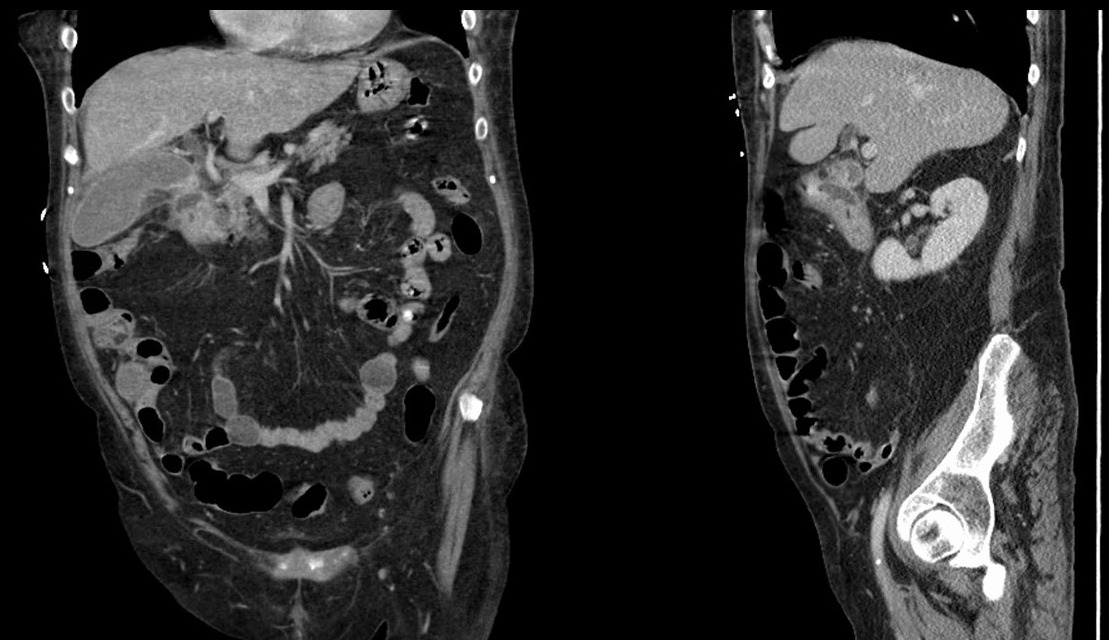Sunday Poster Session
Category: Biliary/Pancreas
P0083 - Cholecystoduodenal Fistula Secondary to Duodenal Ulcer
Sunday, October 22, 2023
3:30 PM - 7:00 PM PT
Location: Exhibit Hall

Has Audio

Alexandria Dennison, MD
HCA
Mission, KS
Presenting Author(s)
Alexandria Dennison, MD, Shruti Verma, MD, Corbin Stephens, MD, Alka Hudson, MD
HCA, Overland Park, KS
Introduction: The presence of a bilioenteric fistula between the gallbladder and the duodenum is called cholecystoduodenal fistula. It is a rare occurrence and is predominantly seen in patients with chronic cholecystitis. Here, we describe a case of a 62 year old woman with peptic ulcer disease presenting with abdominal pain and anemia, who was incidentally found to have a cholecystoduodenal fistula on imaging.
Case Description/Methods: A 62 yo woman presented with dark colored stools for two days and right upper quadrant abdominal pain for two months, along with intermittent nausea and vomiting. Of note, she had previously been diagnosed with a bleeding gastric ulcer for which she was on treatment with pantoprazole and sucralfate. She also had chronic pain for which she was consuming NSAIDs and had been a chronic alcoholic. Upon presentation, she was found to be hypotensive with a Hb of 6.2g/dl , requiring two units PRBC transfusion and had received four units in the last month. CT abdomen revealed a duodenal ulcer distal to the pylorus with adjacent inflammatory stranding. Free air was noted inside the gallbladder with associated wall thickening, pericholecystic fluid and adjacent fat stranding. A fistula between gallbladder and inflamed duodenal ulcer with associated inflammation in the gallbladder neck was also present. Upper GI endoscopy revealed 5mm esophageal ulcers with recent bleeding stigmata and one Forrest Class III duodenal ulcer was present in the first and second portion of the duodenum. Abdominal MRI revealed a distended gallbladder with intraluminal gas and a fistula between the duodenum and gallbladder. Conservative management was chosen for the patient, and she was continued on pantoprazole and sucralfate for 8 weeks followed by repeat endoscopic examination.
Discussion: Bilio enteric fistulas may lead to obstructive or nonobstructive symptoms and their identification can be difficult due to their varied presentation. Air within the gallbladder can be consistent with chole-enteric fistula and gangrenous/emphysematous cholecystitis. Spontaneous resolution of cholecystoduodenal fistula secondary to the duodenal ulcer occurs in most cases, however surgical intervention may also be performed if they do not heal (1).
1. Dias E, Marques M, Azevedo F, Macedo G. Spontaneous Resolution of Cholecystoduodenal Fistula Secondary to Duodenal Ulcer. J Gastrointestin Liver Dis. 2022;31(3):271. Published 2022 Sep 15. doi:10.15403/jgld-4250

Disclosures:
Alexandria Dennison, MD, Shruti Verma, MD, Corbin Stephens, MD, Alka Hudson, MD. P0083 - Cholecystoduodenal Fistula Secondary to Duodenal Ulcer, ACG 2023 Annual Scientific Meeting Abstracts. Vancouver, BC, Canada: American College of Gastroenterology.
HCA, Overland Park, KS
Introduction: The presence of a bilioenteric fistula between the gallbladder and the duodenum is called cholecystoduodenal fistula. It is a rare occurrence and is predominantly seen in patients with chronic cholecystitis. Here, we describe a case of a 62 year old woman with peptic ulcer disease presenting with abdominal pain and anemia, who was incidentally found to have a cholecystoduodenal fistula on imaging.
Case Description/Methods: A 62 yo woman presented with dark colored stools for two days and right upper quadrant abdominal pain for two months, along with intermittent nausea and vomiting. Of note, she had previously been diagnosed with a bleeding gastric ulcer for which she was on treatment with pantoprazole and sucralfate. She also had chronic pain for which she was consuming NSAIDs and had been a chronic alcoholic. Upon presentation, she was found to be hypotensive with a Hb of 6.2g/dl , requiring two units PRBC transfusion and had received four units in the last month. CT abdomen revealed a duodenal ulcer distal to the pylorus with adjacent inflammatory stranding. Free air was noted inside the gallbladder with associated wall thickening, pericholecystic fluid and adjacent fat stranding. A fistula between gallbladder and inflamed duodenal ulcer with associated inflammation in the gallbladder neck was also present. Upper GI endoscopy revealed 5mm esophageal ulcers with recent bleeding stigmata and one Forrest Class III duodenal ulcer was present in the first and second portion of the duodenum. Abdominal MRI revealed a distended gallbladder with intraluminal gas and a fistula between the duodenum and gallbladder. Conservative management was chosen for the patient, and she was continued on pantoprazole and sucralfate for 8 weeks followed by repeat endoscopic examination.
Discussion: Bilio enteric fistulas may lead to obstructive or nonobstructive symptoms and their identification can be difficult due to their varied presentation. Air within the gallbladder can be consistent with chole-enteric fistula and gangrenous/emphysematous cholecystitis. Spontaneous resolution of cholecystoduodenal fistula secondary to the duodenal ulcer occurs in most cases, however surgical intervention may also be performed if they do not heal (1).
1. Dias E, Marques M, Azevedo F, Macedo G. Spontaneous Resolution of Cholecystoduodenal Fistula Secondary to Duodenal Ulcer. J Gastrointestin Liver Dis. 2022;31(3):271. Published 2022 Sep 15. doi:10.15403/jgld-4250

Figure: Gas in the biliary tract with contrast
Disclosures:
Alexandria Dennison indicated no relevant financial relationships.
Shruti Verma indicated no relevant financial relationships.
Corbin Stephens indicated no relevant financial relationships.
Alka Hudson indicated no relevant financial relationships.
Alexandria Dennison, MD, Shruti Verma, MD, Corbin Stephens, MD, Alka Hudson, MD. P0083 - Cholecystoduodenal Fistula Secondary to Duodenal Ulcer, ACG 2023 Annual Scientific Meeting Abstracts. Vancouver, BC, Canada: American College of Gastroenterology.
